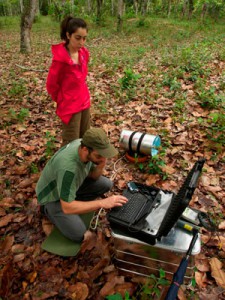Immediate on-site CO2 measurement
To operate the dynamic closed chamber systems for gas sampling (SEMACH-FG) and to inform yourself about the CO2 determination method, please refer to the respective manual. → Downloads
Gas sampling — for subsequent lab analysis of CH4 and N2O

A first gas sample is taken immediately at the beginning of the last CO2 measurement cycle (sample 0 min), a second one after the 6-minute interval. Thereafter, samples taken at 5-minute intervals for a total of 30-minutes (=standard procedure. For specific questions, a last sample is taken from each location after 45 min). All samples are taken through the luer-lock interface at the top of the chamber and injected into 12 mL Exetainer® vials (Labco, England), using appropriate disposable syringes and needles that are discarded after each location. A new pair is used for the next sampling location.
While we obtain immediate results for CO2 concentrations in the field, methane (CH4) and nitrous oxide (N2O) can be determined in the lab only by gas chromatography. At this point, we re-analyze CO2 once again to have an independent quality control.
Results
In mid April 2017, we have analyzed all gas samples from phases 01 and 02 by gas chromatography, delivering additional values for methane and nitrous oxide fluxes. The 2017 samples are in process; results should be available shortly. The carbon dioxide data which were analyzed in parallel agree well with the initial field analysis by IR-spectrometry. Data are available upon request. Sampling for the project is now complete.
The median value of forested soils was 5.8 µmol CO2 m-2 sec-1 in the first wet season and 3.8 µmol CO2 m-2 sec-1 in the extreme dry season. In non-forested soils 3.4 µmol CO2 m-2 sec-1 (weak wet season) and 2.8 µmol CO2 m-2 sec-1 (dry season). These data lie in the range of previously observed data (Oertel et al. 2016). They are mostly mid-day results. The last field campaign tested reproducibility for the wet season. Since that wet season was a strong one, we see an increase from the lowest emission during the dry season via the weak wet to the strong wet season. Data for methane and nitrous oxide upon request.
